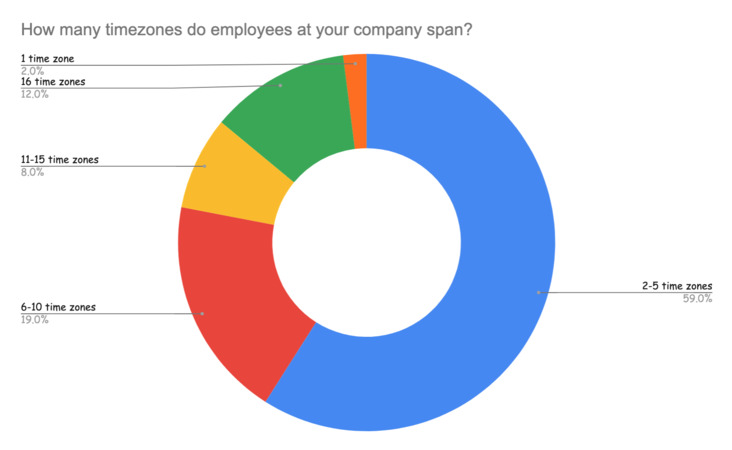Best Options to Solve Challenges With Distributed Teams
Today, geographically distributed teams are not uncommon and the number of tech companies moving to a distributed work model is increasing every year. Members of the same team can be in different locations and in different time zones. But how to manage such a team? How to keep a distributed team united and motivated?
Since most teams now consist of remote employees, managing a team scattered across different locations can be a challenge. Given that, we are going to find out what a geographically dispersed team is, take a closer look at 7 problems that you may encounter and approaches to solve them.
What Is a Distributed Team?
Before diving into the problems and their solutions, let’s first define what a distributed team is. A distributed team is a group of employees who work remotely from different locations: be it another city, country or even a continent. This means that team members do not have to share the same collaborative workspace or be in a specific geographic area.
Also, in geographically distributed teams, some employees may work from the office while others may work individually in the co-working or from home. By using communication and coordination tools and programs, teams can easily collaborate and achieve goals.
Benefits of Geographically Dispersed Teams
Get multiple perspectives on the job: When you hire employees in different locations, you are more likely to expand your team with people from different cultures. Having a diverse team provides many benefits, for example, more interesting, creative and out-of-the-box ideas.
Find talent regardless of the location: The distributed team model expands the search for candidates. Companies can hire talented and skilled experts, no matter where they are located geographically.
Expanded working hours: Companies that have customers in other time zones will benefit from having team members from different locations. Increasing working hours will lead to more stable customer service.
Reduced office and operational costs: Your dispersed team won’t need a large shared office, therefore, you can cut costs by using a smaller office. All office expenses are excluded if your team is completely distributed.
Is There Any Difference Between Distributed, Dispersed and Remote Teams
“Distributed team” vs “dispersed team” vs “remote team”. It may seem that there is no difference between these terms and they mean the same thing. Indeed, there are similarities: employees work independently, away from the company’s office, and their work does not depend on other colleagues and team members.
When it comes to the integration of teams, the way they communicate with each other, and the location of offices, that’s where the similarities end. Let’s take a closer look at distributed & dispersed & remote teams and find out how they differ.
A distributed team refers to multiple teams working on the same project; teams are in different locations, but participants of the single team usually work in the same geographic area. For example, if a company has teams in New York, San Francisco, and Chicago, the company has 3 distributed teams.
Dispersed teams are teams whose members are spread across a country or the world. This could mean members of the same team are working from home, co-working spaces or offices from completely different locations around the world. For example, if the team consists of 2 designers from New York, a developer from Chicago, and testing staff from San Francisco, the team is dispersed.
Remote team members also work away from each other. But they, as a rule, are not distributed around the world, they usually work in close proximity to the office and can meet periodically.
Top 7 Challenges Working With Distributed Teams
How do geographically dispersed teams collaborate effectively? While there are many benefits, managing a distributed team can create many pitfalls in certain situations. Without further ado, here are 7 common challenges that may arise.
1. Productivity Issues
The effectiveness of the company largely depends on how well-coordinated and motivated the team works. To achieve the set goals, all employees must complete their tasks on time, efficiently and in accordance with company standards. When managing a remote team, it can be difficult to understand exactly how long an employee has been working on a given task. Therefore, it is important to think over and implement methods of interaction and control. This will help make the workflow as transparent as possible and avoid misunderstandings and delays.
Solution
Set clear expectations: All expectations must be clearly defined and expressed. If your team doesn’t fully understand what you expect from them, it can lead to problems down the road, including disruption to workflow. Specify what tools you will use, when projects are due to be completed, and so on.
Use the right tools: Within the team, it is recommended to use the following tools:
- Jira, Trello, Asana – for project management;
- Slack, Google Meet – for daily communication with your team;
- Zoom – for video conferencing;
- Confluence – for creating a unified knowledge base.
Meghan Keaney Anderson, CMO and former HubSpot employee, says:
“At HubSpot, we use Slack to keep conversations going remotely, Trello to keep us organized around priorities, and Google Hangouts plus Webex to make remote meetings more productive. Getting the right stack of support tools to fit your work style makes a big difference.”
Have clear workflows: To understand who is responsible for a particular task, at what stage the project is, it is necessary to build clear workflows. Project management tools will help you plan, organize and track the work of employees. You will have a visual representation of all the aspects, and work processes become more organized.

Track project progress: Regular checks may seem like overkill, but they are vital to keeping employees productive and engaged in the process. Schedule team meetings to discuss project statuses, risks, issues, and goals. Online team meetings in the format of planning and prioritizing plans for the week are also effective.
More on this topic for you:
2. Lack of In-Person Interaction
According to a recent survey, the biggest challenge for remote employees is the lack of interaction. When working in the office, you can kick ideas around over lunch in the cafeteria or just chat with colleagues over a morning coffee, while when working remotely, communication is significantly reduced. Remote workers may feel lonely and isolated, which can result in decreased motivation to work. So, you should get creative with ways to achieve team bonding when the team is physically separated.

Solution
Foster small talks or virtual team hangouts: “Water cooler” chats are an integral part of office work for many employees. These conversations greatly strengthen cooperative relationships between colleagues.
Thanks to communication tools, casual “water cooler” talks or coffee breaks can also be virtual. You can create channels in Microsoft Teams or Slack so team members can chat and have casual conversations. If your team uses Slack, you can also try the Donut app. It randomly connects colleagues for informal communication, as if they met at a water cooler and started a conversation. This will help remote team members feel connected to each other and build rapport.

Liam Griffin, Shopify Senior Developer Advocate, says:
“Daily rituals, like a 15-minute virtual team hangout in the morning, or simply messaging your colleagues to see how they are getting on can seem like minor activities, but these interactions can make a big difference. It’s likely everyone will feel isolated at some point when working from home, and creating a more connected culture with your team will help when it happens.”
Encourage a video-first culture: Video conferencing is essential when face-to-face meetings are not possible. Video conferencing tools like Zoom, Google Hangouts Meet provide a much-needed social aspect of the working day and help close the distance between teams. This is more effective than chats and audio calls, as you can see the emotions of the interlocutor.
Here’s how Doist built the communication between its team members: at Doist, team communication is based on asynchrony. This type of communication helps to focus on work and not be distracted by messages that require an immediate response. For asynchronous messaging, the company created Twist. Doist also uses in-context comments on tasks, copy, code, design. Among the tools used: Todoist, Google Docs, GitHub, Marvel.
When it comes to synchronous communication, the company tries to hold only meetings that are of value. Each team has its own meeting norms, but the most commonly used types are monthly one-on-one meetings, regular team meetings, kick-off meetings, and ad-hoc meetings. Depending on the meeting, such tools are used Appear.in, Google Meet, Zoom.

3. Distractions
Distractions are pretty common for remote work. While working from home, many remote workers find it difficult to organize a productive work environment and tune in to “work mode” since there are so many distractions to deal with. Every time we get distracted by household chores, mobile notifications, or conversations with family, the attention is diverted. This may adversely affect performance.
Solution
Help your remote workers create a more productive work environment by equipping them with everything they need to work from “home office”: desks, computers, chairs and headphones. Alternatively, renting places in co-working spaces, where team members can easily concentrate on work, will help deal with this challenge.
Alex Turnbull, Founder & CEO of Groove, shares some facts about Groove’s remote work culture:
“The number one thing we look for in a remote employee is the skill of working remotely…One of the ways that we look for this skill is by asking questions like ‘what does your work setup look like?’ in interviews. If someone hasn’t put much thought into their setup and works from their couch 100% of the time, or worse, ‘doesn’t know yet,’ this signals that they might not be ready for a remote position yet.”
4. Difficulty Maintaining Company Culture
Developing and maintaining an internal corporate culture is also important when working remotely. Recent surveys show that companies with a strong positive culture, as a rule, have more engaged and productive employees.
Maintaining the corporate culture of the company where employees work remotely, is a rather daunting task. Given that distributed teams communicate and interact virtually, not in a physical office, remote employees often feel disconnected from the company culture.
Solution
Provide more opportunities for communication and team building: To build a strong culture, it is necessary to set up high-quality communication and give your team a variety of opportunities to get to know each other and network with other members of the team. Use video conferencing tools to communicate face-to-face. Consider hosting regular team video hangouts where team members can chat about non-work related topics.
How about a weekend for team building activities? If possible, hold yearly (or more regular) face-to-face meetings. For example, the Doist team organizes company and team retreats every year:
“We have an annual company retreat where we fly the entire company out to one location in the world to spend a week together reinforcing those social and professional ties.”
5. Language and Cultural Barriers
Language and cultural differences are other challenges of working in a team scattered across the globe. Many companies hire people from all over the world, so a dispersed team can be made up of employees with vastly different cultures, languages and communication styles.
Working in a cross-cultural remote team, you are surrounded by different points of view and ideas, and this is a big plus. However, different cultures have different values and norms, different work styles, may be less prone to self-organization, and so on. Sometimes it can be a challenge to overcome cultural differences and find common ground. Misunderstandings may arise and team members may not be able to work effectively together. What to do in this case?

Solution
Acknowledge language and culture barriers. If team members speak different languages, ask them to avoid using idioms, slang or jargon words that many may not understand. Make sure team members speak clearly and slowly enough for others to understand. Host icebreaker meetings to ask questions and learn about each other’s cultures.
Address conflict immediately. If there is a misunderstanding between members of your team due to a language barrier, you need to quickly take action to resolve it as quickly as possible. Do not ignore it.
Over-communicate: Share what tasks other team members are working on, talk about what is happening in other departments of the company. This will help build team spirit, get people involved, and show that you trust your team.
6. Time Zone Mismatch
Often, distributed teams have people living in different time zones. When your work day is in full swing, other team members may have an early morning. How to work effectively in such conditions? With a big gap between certain time zones, holding meetings at a convenient time for each team member is tricky. Teams also may experience delayed responses. Therefore, it is very important to organize the work of a geographically dispersed team, given that its members are located in different countries and cities.

Source: https://buffer.com/state-of-remote-work/2021
Solution
Use the dedicated tools. Working in different time zones requires careful planning. When planning meetings or releases, tools like Every Time Zone and World Clock Meeting Planner will be helpful. With the visual time zone converters, you can easily find the time difference between places and choose the most suitable time that falls within everyone’s normal daytime business hours. For example, the World Clock Meeting Planner enables choosing the location and date for the meeting. The tool then highlights times in green, yellow and red.
Overlapping daytime hours will also give you an idea of when remote members of your team can quickly respond to messages. But if your team consists of employees from completely different time zones, managing work will be a little more difficult and will require a creative approach.
Let’s see how HubSpot handles the issue of time zone differences. Lestraudra Alfred, a California-based marketing manager and staff writer for the HubSpot Blog, says:
“When working with team members from different timezones regarding deadlines, I’ve found it helpful to explicitly state the deadline we are working to in both my timezone, and their timezone so there is no confusion on either end when the deliverable is expected to be complete.”
Video conference recording. You may also consider recording a video meeting so that those team members who were unable to attend the meeting can easily view it later. Make sure the team members who work in a different time zone know all the steps involved in getting the job done and have everything they need to work effectively to complete their tasks seamlessly. Alternatively, at the end of the day, sum up the results of the working day and send it to all members of the distributed team. This can be a checklist, etc.
7. Lack of Motivation
One of the biggest challenges is keeping inspiration and engagement across geographically dispersed teams. Employee motivation plays a key role in team performance. According to the Harvard Business Review, there are three negative motivators that can contribute to a decline in work productivity. This includes emotional pressure, economic pressure and inertia.
Solution
Let your team members know that their work is appreciated. Working from home can make employees feel left out and, after a while, unmotivated. To make your team feel noticed and appreciated, reward their efforts and job. Please ensure and provide positive feedback and assessment of professional skills.
Provide the best hardware for work. Outdated hardware can be a source of demotivation for remote employees. Make sure your team has good working equipment – the laptop, computer, keyboard, mouse, webcam, etc.
Encourage skill enhancement. Motivation and self-development are closely related. If a team member strives to improve skills or learn new things, you can support the initiative and offer something on behalf of the company. Thus, by showing concern, you motivate your employees and get highly qualified workers.
Build trust and rapport with remote teams. Micromanagement is an easy way to demotivate a team. Meticulous control does nothing to maintain a healthy working atmosphere.
8. Give Remote Employees Excellent It Support
Maximizing remote assistance software is critical for quickly fixing technical problems that distributed teams run into on their devices without disturbing their work. Through creating remote connections, support personnel can immediately diagnose and troubleshoot issues, ensuring speedy resolution.
Such a tool has remote control functionality that lets support staff provide prompt assistance, access the worker’s system, and recognize the cause. With this, employees don’t have to do troubleshooting or give intricate explanations.Additionally, remote support software consists of collaborative features, including chat, that permit workers to be active in the process.
Solution
Remote support software, such as HelpWire, can help enterprises provide efficient support to their remote employees and settle PC and Mac issues immediately while reducing workflow interruptions and keeping up productivity.
Conclusion
Geographically distributed teams have lots of benefits, including cost savings, access to talent from around the world, and more. However, managing such a team is not easy, as there are many additional coordination issues associated with different time zones, languages, and cultures.
The challenges to managing geographically distributed team are varied and cannot be ignored. As the leader of a remote team, you should identify potential issues and establish clear strategies that work for your team: set expectations clearly, provide feedback, hold regular team meetings, use the right project management and communication tools, and maintain team spirit and company’s values. This is not the whole list, but these are the main points to consider when managing a distributed team.